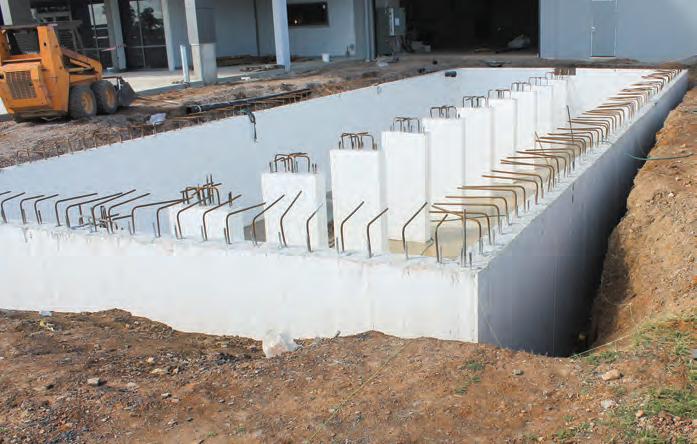
4 minute read
Structural walls for civil
A CIVIL SOLUTION:
DINCEL 275
A NEW WALLING SOLUTION FROM DINCEL STRUCTURAL WALLING WILL ENABLE CIVIL CONSTRUCTION PROJECTS TO BYPASS THE USE OF STEEL REINFORCEMENT, IMPROVING A PROJECT’S PRODUCTIVITY AND CARBON FOOTPRINT.
Strength tests by the University of Technology Sydney showed the Dincel 275, a new structural walling innovation, can be implemented without the use of steel reinforcement bars when in-filled with mass concrete, or macro synthetic fibre (BarChip) reinforced concrete.
Dincel (as a company) has been around for decades, its origins began in New South Wales as an engineering consulting business. In 2006 the business evolved to manufacture walling solutions.
The owner and inventor found there was a need to create a new walling system to speed up construction and make life simpler for construction workers.
This is where Dincel Structural Walling was born. The Dincel product has been used in a wide range of applications from residential and commercial to civil projects.
Dincel walling profiles are connected together with a simple snap lock joint and filled with concrete. Once filled with concrete, the formwork stays in place and acts as a waterproof protective membrane.
The same applies to Dincel’s newer product, the Dincel 275. This product however, is specially designed for larger and heavier construction work.
Berkay Dincel, Director of Dincel Construction System, says one of the innovative aspects of the Dincel 275 is the unique design.
“The middle of the Dincel 275 formwork shell consists of a cylindrical ring which is unique. It gives the formwork quite a lot of strength” he says.
Dincel 275 can withstand high slump concrete, high pour lifts, and with the omission of horizontal steel reinforcement bars in particular, air void free concrete is ensured. The use of this profile helps to increase the asset’s life as potential corrosion issues are prevented and waterproofing of the wall is not required.
Dincel walling at the Gundagai Sewerage Plant.
“Concrete walls are steel reinforced and we wanted to explore if we could create a wall solution for civil applications without steel bars in it at all.”
To ensure that the system is safe for use without steel reinforcement, Dincel partnered with the University of Technology Sydney (UTS) for extensive testing.
Tests were completed in line with Australian Standard 3600:2018 (Appendix B) for concrete structures. This sets out the minimum requirements for the design and construction of concrete building structures and members that contain reinforcing steel or tendons, or both.
“We tested the walls with mass concrete inside and then with a synthetic fibre concrete, without the use of steel bars,” Dincel says.
Each tested system was certified by UTS as compliant with the National Construction Code.
The Dincel 275 walls are also able to be back-filled 24 hours after the concrete in
fill, as long as the walls are appropriately braced. This allows construction of the super structure to take place earlier.
To prove this, UTS undertook testing in which significant loading was applied onto the Dincel 275 walls containing both early age concrete (after 24 hours) and later age concrete (after 28 days).
Robert Merjane, Technical Manager at Dincel, says there are multiple benefits of the Dincel 275 product. These include speed, safety, lower cost, and sustainability.
“Steel for reinforcement can make up a significant cost on any project and reducing or eliminating the need for wall steel reinforcement can present huge saving opportunities,” Merjane says.
In its 2020 “Start with steel” report, the Grattan Institute stated steel contributes to a seven per cent share of global emissions.
“In terms of manufacturing, steel production is well known as one of the world’s largest sources of emissions, so reducing or eliminating the need for steel reinforcement can improve the overall carbon footprint of projects,” Merjane says.
He says there are also significant time savings to be had by using the Dincel 275 structural walling solution.
“There are two parts to the speed advantage, one is the product itself, the snap-lock action to connect the profiles significantly reduces the time spent building up formwork. Then second is after you pour the concrete, it doesn’t need to be stripped out of the Dincel protective formwork shell,” he says.
In early 2020, Dincel put its solution to the test at the Gundagai Sewerage Treatment Plant in NSW.
Cootamundra-Gundagai Regional Council’s Sewerage Treatment Plant was around 100 years old and had been subject to flood damage.
Dincel Structural Walls were chosen to create new retaining walls at the plant, capable of withstanding a minimum one in 100-year flooding event.
The team created custom lengths of the Dincel 275 profile for the plant and the contractors DET Constructions were impressed with the results.
David Tout from DET Constructions estimated using Dincel 275 walling achieved cost savings of around 60 per cent per square metre of the retaining wall.
He said, in an interview with Dincel,
An on-site detention tank using Dincel Walling.

that with conventional formwork often a crane would be needed alongside more workers on site. However, using Dincel 275 eliminated the need for a crane as workers simply snapped the Dincel wall formwork into place.
Tout also found the walling solution was particularly easy to install with minimal bracing required.
So far, the Dincel 275 solution has been
Top view of the Dincel 275 formwork shell. used across a wide range of projects such as culverts, retaining walls, detention tanks, walkway tunnels, batching plant walls and even sea walls.
As an Australian invented and manufactured product, Dincel Structural Walling is excited for this product to grow in the Australian market and change the way walls are built across civil construction projects.











